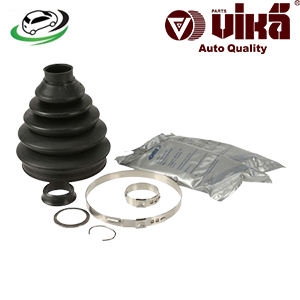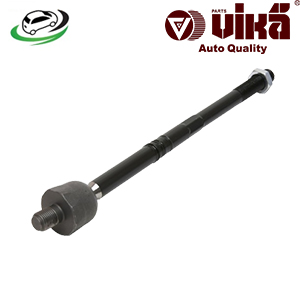-17%
Get Inner Tie Rod End AUDI A3/Golf V-Passat 3C2/3C5 Touran 1K0423810A
The tie rod end is a critical component in a vehicle’s steering and suspension system. It plays a vital role in ensuring precise steering control and stability. This article provides an in-depth look at the function of tie rod ends, the different types available, their benefits, common symptoms of wear, and essential maintenance tips to ensure optimal vehicle performance.
Function of the Tie Rod End
- Steering Linkage:
- Primary Role: The tie rod end connects the steering rack or gearbox to the steering knuckle, translating the movement of the steering wheel into actual movement of the wheels.
- Mechanism: When you turn the steering wheel, the tie rod end transmits this movement to the wheels, allowing the vehicle to turn in the desired direction.
- Alignment and Stability:
- Primary Role: Tie rod ends help maintain proper wheel alignment, which is crucial for stable handling and even tire wear.
- Mechanism: By ensuring that the wheels are aligned correctly with the vehicle’s steering axis, tie rod ends contribute to smooth and predictable vehicle handling.
- Damping and Absorption:
- Primary Role: Tie rod ends absorb and dampen shocks and vibrations from the road, reducing the impact on the steering system and improving ride comfort.
- Mechanism: The tie rod end’s design allows it to flex and absorb road impacts, providing a smoother driving experience.
Types of Tie Rod Ends
- Outer Tie Rod Ends:
- Description: Located on the end of the tie rod and connects to the steering knuckle.
- Function: Directly impacts the wheel’s movement and plays a crucial role in steering control and alignment.
- Inner Tie Rod Ends:
- Description: Connects the tie rod to the steering rack or gearbox, often located closer to the center of the vehicle.
- Function: Transfers movement from the steering rack to the outer tie rod end, helping to steer the vehicle.
- Adjustable Tie Rod Ends:
- Description: Feature a threaded design that allows for length adjustments.
- Function: Used for fine-tuning alignment settings, ensuring precise steering adjustments.
- Fixed Tie Rod Ends:
- Description: Non-adjustable tie rod ends with a fixed length.
- Function: Standard design used in many vehicles where no additional alignment adjustments are needed.
Benefits of Proper Tie Rod End Maintenance
- Improved Steering Precision:
- Benefit: Properly functioning tie rod ends ensure accurate steering control, providing a more responsive and predictable driving experience.
- Explanation: By maintaining the correct alignment and connection between the steering system and wheels, tie rod ends help achieve precise steering input.
- Enhanced Vehicle Stability:
- Benefit: Well-maintained tie rod ends contribute to overall vehicle stability, reducing the risk of handling issues and improving cornering performance.
- Explanation: Proper alignment and stable steering help keep the vehicle’s wheels aligned with the driving direction, enhancing stability.
- Reduced Tire Wear:
- Benefit: Correctly functioning tie rod ends prevent uneven tire wear and extend the lifespan of tires.
- Explanation: Proper alignment ensured by tie rod ends prevents tires from wearing out prematurely due to misalignment or improper steering angles.
- Increased Safety:
- Benefit: Functional tie rod ends contribute to safer driving by maintaining proper steering control and vehicle stability.
- Explanation: Effective steering and alignment reduce the risk of accidents caused by steering failures or handling issues.
- Enhanced Ride Comfort:
- Benefit: Tie rod ends help absorb and dampen road impacts, leading to a smoother and more comfortable ride.
- Explanation: By reducing vibrations and shocks transmitted through the steering system, tie rod ends contribute to a more pleasant driving experience.
Symptoms of a Faulty Tie Rod End
- Steering Play or Looseness:
- Symptom: Excessive play or looseness in the steering wheel.
- Cause: Worn or damaged tie rod ends can cause a loose or vague steering feel.
- Consequence: Reduced steering control and potential handling issues.
- Uneven or Rapid Tire Wear:
- Symptom: Tires show uneven wear patterns or tread damage.
- Cause: Faulty tie rod ends can cause misalignment, leading to uneven tire wear.
- Consequence: Reduced tire lifespan and increased replacement costs.
- Clunking or Knocking Noises:
- Symptom: Audible clunking or knocking noises when turning or driving over bumps.
- Cause: Damaged or worn tie rod ends may produce noise due to loose or degraded components.
- Consequence: Potential for further damage and impaired handling.
- Vibration in the Steering Wheel:
- Symptom: Vibrations or shimmying in the steering wheel.
- Cause: Worn tie rod ends can cause steering instability and vibrations.
- Consequence: Reduced driving comfort and potential safety issues.
- Steering Wheel Off-Center:
- Symptom: Steering wheel is not centered or feels off during driving.
- Cause: Misalignment caused by faulty tie rod ends can affect steering wheel positioning.
- Consequence: Poor vehicle handling and potential alignment problems.
Maintenance and Replacement Tips
- Regular Inspections:
- Tip: Periodically inspect tie rod ends for signs of wear or damage. Check for any play, looseness, or visible damage.
- Frequency: Inspections should be part of routine maintenance checks, especially when performing wheel alignments or suspension work.
- Timely Replacement:
- Tip: Replace faulty tie rod ends promptly to prevent further damage to the steering system and ensure safe driving.
- Indication: Replace tie rod ends as soon as symptoms of wear or damage are noticed.
- Professional Alignment:
- Tip: After replacing tie rod ends, have a professional alignment performed to ensure proper steering angles and alignment settings.
- Reason: Proper alignment ensures that the new tie rod ends function correctly and prevents uneven tire wear.
- Use Quality Parts:
- Tip: Choose high-quality tie rod ends that meet or exceed OEM specifications for durability and performance.
- Reason: Quality parts ensure reliable steering performance and long-term durability.
- Check for Other Issues:
- Tip: When inspecting or replacing tie rod ends, also check for other related components, such as ball joints and suspension parts, to ensure overall system health.
- Reason: Addressing any related issues can prevent further complications and maintain vehicle safety.
- Follow Manufacturer’s Recommendations:
- Tip: Adhere to the vehicle manufacturer’s recommendations for tie rod end maintenance and replacement intervals.
- Reason: Manufacturer guidelines ensure that the vehicle’s steering system is maintained according to the specific requirements.
Follow us on Facebook for more parts.



